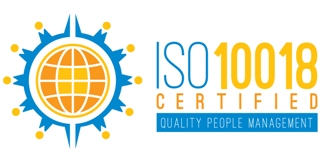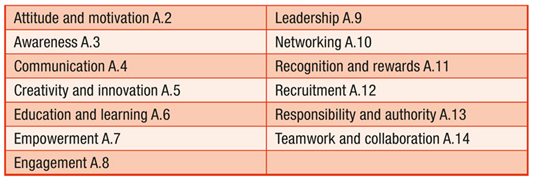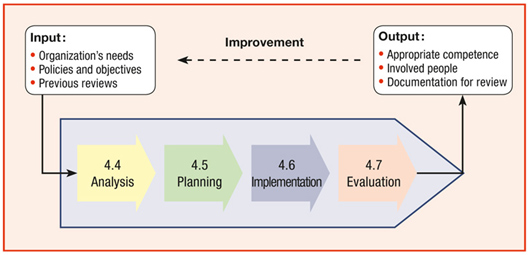Primer on ISO 10018 Quality People Management Standards and Certification
Based on ISO 10018 Guidelines on People Involvement and Competency
- Overview
- Key Principles of Quality People Management
- Elements of Quality People Management
- How and Why Organizations Comply with ISO Standards
- Economic Justification
- ISO 10018:2012 Certification
This primer provides an overview of ISO 10018
 The 10018:2012 Guidelines on People Involvement and Competence were created by the ISO (International Organization for Standardization) Technical Committee ISO/TC 176, Quality management and quality assurance, Subcommittee SC 3, Supporting technologies.
The 10018:2012 Guidelines on People Involvement and Competence were created by the ISO (International Organization for Standardization) Technical Committee ISO/TC 176, Quality management and quality assurance, Subcommittee SC 3, Supporting technologies.These standards are based on the premise that “the overall performance of a quality management system and its processes ultimately depends on the involvement of competent people and whether they are properly introduced and integrated into the organization,” according to a summary of the standards published by ISO. “The involvement of people is important in order for an organization’s quality management system to achieve outcomes which are consistent and aligned with their strategies and values. It is critical to identify, develop and evaluate the knowledge, skills, behavior and work environment required for the effective involvement of people with the necessary competence.”
This international standard provides guidelines for human factors which influence people involvement and competence, and creates value that helps to achieve the organization’s objectives. While the standard was created specifically for the application of quality management, its creators suggest that it has application for any management system.
Key Principles of Quality People Management
The underlying distinguishing factor of ISO 10018:2012 is the attempt to bring a process approach to Quality People Management. The standards are based on the following Quality Management Principles created by ISO Technical Committee 176:- Customer focus to align activities and priorities in service to the consumers of an organization’s services or products.
- Leadership that insures people feel inspired, have the information and knowledge needed to do their jobs and feel part of a community so that they have a sustainable passion for success.
- Involvement of people so that everyone acts as the eyes and ears of the organization.
- A process approach to provide a systematic, as opposed to an ad hoc, approach to achieving goals.
- A systematic approach to management that ensures alignment of all key tools of engagement.
- Continuous improvement: a culture committed to innovation.
- A factual approach to decision-making rather than influenced by political or factional biases.
- Mutually beneficial supplier relationships.
Elements of Quality People Management
The standards involve:- Customer focus to ensure the organization continually aligns activities with needs of customers.
- Communication that connects the entire organization to values, goals and objectives.
- Recruitment to ensure the selection of people appropriate to their function.
- Awareness of the importance of the Quality Management process.
- Engagement strategically implemented so that people feel continually committed to improvement.
- Teamwork and collaboration so that teams function effectively and efficiently.
- Responsibility and authority is properly delegated by managers to ensure front-line managers involve and inspire their employees to continually address customer needs.
- Creativity and innovation is built into the culture and rewards system.
- Recognition and rewards are strategically used to foster involvement and a positive and fun atmosphere.
- Networking is encouraged between all parts of the organization to foster alignment.
- The work environment is designed to foster proactive communication, participation and effectiveness.

Quality people management involves a formal process outlined in another ISO chart.

How and Why Organizations Comply with ISO Standards
As of 2014, more than 1.3 million organizations worldwide held ISO 9001 certifications alone.[1] Compliance with ISO standards is voluntary. Organizations follow the standards either to improve processes and quality as an internal exercise, or to become “ISO certified.” Initial certification is typically a three- to six-month process, sometimes including the elevation of processes to meet the standards and then complying thorough documentation of those processes. Once this has been achieved, an initial third-party audit is conducted. ISO itself does not certify. This is done, for a fee, by a network of thousands of certification bodies worldwide.The companies that audit for ISO compliance are always separate from the companies that provide certification support services to minimize the potential for conflict of interest. If an organization passes the certification audit, it receives certification good for three years. If not, the organization must resolve the issues flagged by the audit. To maintain certification, organizations must conduct ongoing annual audits during the three years and a recertification audit at the end of each three-year cycle.[2] [3]
Certification tells an organization’s customers and other stakeholders that the organization has met and adheres to defined quality standards and/or product specifications. This boosts the organization’s reputation for reliability and/or compliance with international standards. It may attract more customers and/or qualify organizations as suppliers to buyers who insist on ISO Certification. [1] Wikipedia (see: https://en.wikipedia.org/wiki/ISO_9000) [2] ACS Registrars (see: http://www.iso9001.com) [3] Quality Digest (see: https://www.qualitydigest.com/inside/quality-insider-article/maintaining-iso-management-standard.html
Economic Justification
Whether with knowledge of ISO standards or not, investors have embraced the importance of engagement and the need for a formal process. CalPERS, the nation’s leading pension fund, submitted a concept paper last year with the Securities & Exchange Commission requesting that public companies be compelled to disclose their human capital investments and information on the engagement of employees and customers, learning and communication practices, incentives and more. (See http://enterpriseengagement.org/Q-A-with-CalPERs-on-its-Strong-Support-for-Human-Capital-Disclosures-by-Public-Companies/)The Human Capital Management coalition of 26 U.S. pension funds, with combined assets of $5.6 trillion, specifically asks public companies to disclose information on human capital investments, employee and customer turnover and much of the same information advocated by CalPERS, which is a member of this coalition. (See http://enterpriseengagement.org/newswire/content/8472962/26-trillion-investor-coalition-sees-link-between-human-capital-management-and-shareholder-return/)
Larry Fink of BlackRock Group, the world’s largest private investment firm, recently called upon public companies to make larger and more strategic investments in human capital and emphasized the need for far greater disclosure on actual practices and results. (See https://www.blackrock.com/corporate/en-us/investor-relations/larry-fink-ceo-letter)
Their interest is justified. In a study published in HBR in 2016, Alex Edmans, Professor at the London Business School, found that companies on the Great Places to Work ™ list consistently outperformed the stock market indices over nearly three decades. Similarly, the Engaged Company Stock Index, managed by analytics firm McBassi & Co., which uses 12 sources to identify companies with high levels of customer, employee and community engagement, has outperformed the S&P 500 by 25.6% over the last four years, with consistent performance from year to year. (See https://hbr.org/2016/03/28-years-of-stock-market-data-shows-a-link-between-employee-satisfaction-and-long-term-value)
ISO 10018:2012 Certification
The International Center for Enterprise Engagement (ICEE) has created the first ISO 10018 certification program. ICEE is a unit of the Healthcare Management Institute of the University of Texas Medical Branch. The International Center for Enterprise Engagement is a joint venture between the Healthcare Management Institute (HMI/UTMB) and the Enterprise Engagement Alliance (EEA) in Hawthorne, NY. HMI was founded by Dr. Ron McKinley, who was Vice President of Human Resources for UTMB, and by Mr. Lee S. Webster, Director of Employee Relations at UTMB, to bring best human resources practices to the healthcare industry and to administer the UTMB’s role as Secretariat for ISO. The HMI is a division of UTMB Healthcare Systems, Inc. UTMB Healthcare Systems Inc. is a non-profit corporation with UTMB as its sole member. UTMB is itself a member of the University of Texas System, one of the nation’s largest university systems.There are two types of ISO 10018 certifications, one for any organization seeking to apply best practices to organization-wide people management to gain a competitive edge, and a second for solution providers. The latter can gain ISO 10018 certification, as can any other, or they can also gain certification as auditors, certifiers and developers to develop new profit centers as engagement solution providers.
Organizations seeking ISO 10018 certification will have to demonstrate a strategic, ongoing and measurable commitment to maximizing organizational results across the enterprise via an audit process like ISO 9001. Solution providers seeking ISO 10018 certification as auditors, certifiers, or developers need to demonstrate during on-premises or face-to-face meetings the capability to provide those services. In most cases, organizations can demonstrate compliance through disclosure of written business plans and demonstration of ongoing practices related to those plans and the measurement systems applied – based both on an onsite visit and subsequent analysis. Depending on the type of certification, solution providers demonstrate in face-to-face meetings their ability to provide an objective audit or certification or, as developers, to offer a comprehensive, measurable result.
Certifications usually are broken into a two-step process involving an evaluation and a completion phase. The evaluation phase benchmarks the organization against best practices and provides it with a gap analysis. Depending on the situation, the organization might turn to an ISO-certified developer to help it bring its practices up to standards, which can require some time. Therefore, the completion phase might not occur for months, or even up to a year or more if an organization is starting from scratch.
As noted above, certifications are good for three years and then must be renewed through an abbreviated process.
1 Wikipedia (see: https://en.wikipedia.org/wiki/ISO_9000)
2 ACS Registrars (see: http://www.iso9001.com)
3 Quality Digest (see: https://www.qualitydigest.com/inside/quality-insider-article/maintaining-iso-management-standard.html)
Contact:
Contact:
Nick Gazivoda
914-591-7600, ext. 238














